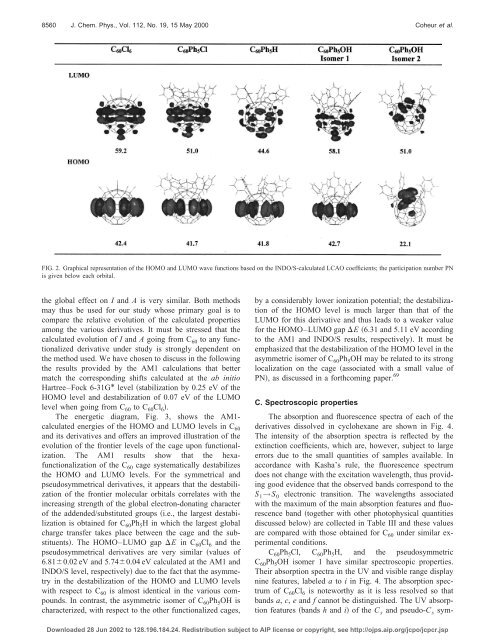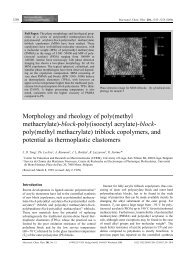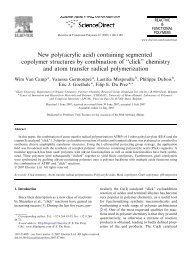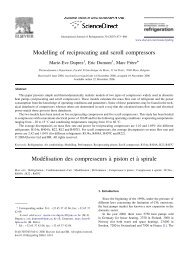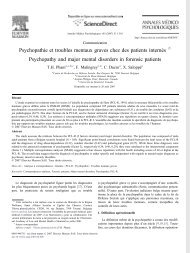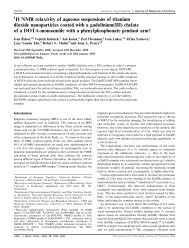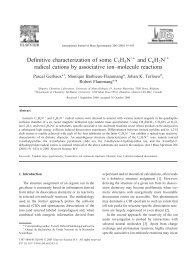Using JCP format - Université de Mons
Using JCP format - Université de Mons
Using JCP format - Université de Mons
Create successful ePaper yourself
Turn your PDF publications into a flip-book with our unique Google optimized e-Paper software.
8560 J. Chem. Phys., Vol. 112, No. 19, 15 May 2000 Coheur et al.<br />
FIG. 2. Graphical representation of the HOMO and LUMO wave functions based on the INDO/S-calculated LCAO coefficients; the participation number PN<br />
is given below each orbital.<br />
the global effect on I and A is very similar. Both methods<br />
may thus be used for our study whose primary goal is to<br />
compare the relative evolution of the calculated properties<br />
among the various <strong>de</strong>rivatives. It must be stressed that the<br />
calculated evolution of I and A going from C 60 to any functionalized<br />
<strong>de</strong>rivative un<strong>de</strong>r study is strongly <strong>de</strong>pen<strong>de</strong>nt on<br />
the method used. We have chosen to discuss in the following<br />
the results provi<strong>de</strong>d by the AM1 calculations that better<br />
match the corresponding shifts calculated at the ab initio<br />
Hartree–Fock 6-31G* level stabilization by 0.25 eV of the<br />
HOMO level and <strong>de</strong>stabilization of 0.07 eV of the LUMO<br />
level when going from C 60 to C 60 Cl 6 .<br />
The energetic diagram, Fig. 3, shows the AM1-<br />
calculated energies of the HOMO and LUMO levels in C 60<br />
and its <strong>de</strong>rivatives and offers an improved illustration of the<br />
evolution of the frontier levels of the cage upon functionalization.<br />
The AM1 results show that the hexafunctionalization<br />
of the C 60 cage systematically <strong>de</strong>stabilizes<br />
the HOMO and LUMO levels. For the symmetrical and<br />
pseudosymmetrical <strong>de</strong>rivatives, it appears that the <strong>de</strong>stabilization<br />
of the frontier molecular orbitals correlates with the<br />
increasing strength of the global electron-donating character<br />
of the ad<strong>de</strong>n<strong>de</strong>d/substituted groups i.e., the largest <strong>de</strong>stabilization<br />
is obtained for C 60 Ph 5 H in which the largest global<br />
charge transfer takes place between the cage and the substituents.<br />
The HOMO–LUMO gap E in C 60 Cl 6 and the<br />
pseudosymmetrical <strong>de</strong>rivatives are very similar values of<br />
6.810.02 eV and 5.740.04 eV calculated at the AM1 and<br />
INDO/S level, respectively due to the fact that the asymmetry<br />
in the <strong>de</strong>stabilization of the HOMO and LUMO levels<br />
with respect to C 60 is almost i<strong>de</strong>ntical in the various compounds.<br />
In contrast, the asymmetric isomer of C 60 Ph 5 OH is<br />
characterized, with respect to the other functionalized cages,<br />
by a consi<strong>de</strong>rably lower ionization potential; the <strong>de</strong>stabilization<br />
of the HOMO level is much larger than that of the<br />
LUMO for this <strong>de</strong>rivative and thus leads to a weaker value<br />
for the HOMO–LUMO gap E 6.31 and 5.11 eV according<br />
to the AM1 and INDO/S results, respectively. It must be<br />
emphasized that the <strong>de</strong>stabilization of the HOMO level in the<br />
asymmetric isomer of C 60 Ph 5 OH may be related to its strong<br />
localization on the cage associated with a small value of<br />
PN, as discussed in a forthcoming paper. 69<br />
C. Spectroscopic properties<br />
The absorption and fluorescence spectra of each of the<br />
<strong>de</strong>rivatives dissolved in cyclohexane are shown in Fig. 4.<br />
The intensity of the absorption spectra is reflected by the<br />
extinction coefficients, which are, however, subject to large<br />
errors due to the small quantities of samples available. In<br />
accordance with Kasha’s rule, the fluorescence spectrum<br />
does not change with the excitation wavelength, thus providing<br />
good evi<strong>de</strong>nce that the observed bands correspond to the<br />
S 1 →S 0 electronic transition. The wavelengths associated<br />
with the maximum of the main absorption features and fluorescence<br />
band together with other photophysical quantities<br />
discussed below are collected in Table III and these values<br />
are compared with those obtained for C 60 un<strong>de</strong>r similar experimental<br />
conditions.<br />
C 60 Ph 5 Cl, C 60 Ph 5 H, and the pseudosymmetric<br />
C 60 Ph 5 OH isomer 1 have similar spectroscopic properties.<br />
Their absorption spectra in the UV and visible range display<br />
nine features, labeled a to i in Fig. 4. The absorption spectrum<br />
of C 60 Cl 6 is noteworthy as it is less resolved so that<br />
bands a, c, e and f cannot be distinguished. The UV absorption<br />
features bands h and i of the C s and pseudo-C s sym-<br />
Downloa<strong>de</strong>d 28 Jun 2002 to 128.196.184.24. Redistribution subject to AIP license or copyright, see http://ojps.aip.org/jcpo/jcpcr.jsp


